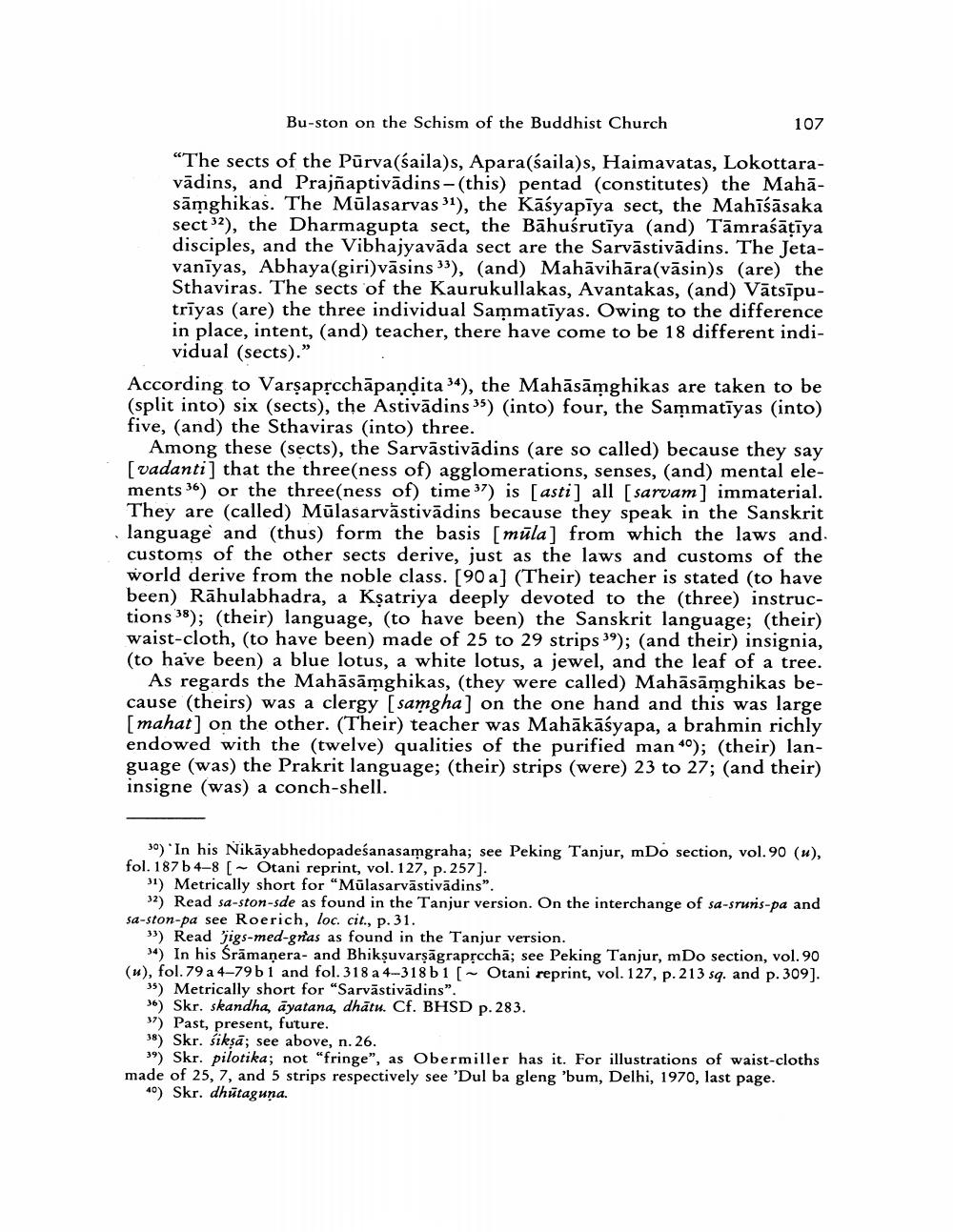________________
Bu-ston on the Schism of the Buddhist Church
107
"The sects of the Pūrva(saila)s, Apara(saila)s, Haimavatas, Lokottaravādins, and Prajñaptivādins -(this) pentad (constitutes) the Mahāsāmghikas. The Mülasarvas 31), the Kāśyapīya sect, the Mahīśāsaka sect), the Dharmagupta sect, the Bāhuśrutiya (and) Tāmraśātīya disciples, and the Vibhajyavāda sect are the Sarvāstivādins. The Jetavaniyas, Abhaya(giri)vāsins 33), (and) Mahāvihāra(vāsin)s (are) the Sthaviras. The sects of the Kaurukullakas, Avantakas, (and) Vātsīputrīyas (are) the three individual Sammatiyas. Owing to the difference in place, intent, (and) teacher, there have come to be 18 different indi
vidual (sects).” According to Varşaprcchāpandita 34), the Mahāsāmghikas are taken to be (split into) six (sects), the Astivādins 35) (into) four, the Sammatīyas (into) five, (and) the Sthaviras (into) three.
Among these (sects), the Sarvāstivādins (are so called) because they say [vadanti] that the three(ness of) agglomerations, senses, (and) mental elements 36) or the three(ness of) time 37) is [asti] all (sarvam] immaterial. They are (called) Mūlasarvāstivādins because they speak in the Sanskrit language and (thus) form the basis [müla] from which the laws and customs of the other sects derive, just as the laws and customs of the world derive from the noble class. [90 a) (Their) teacher is stated (to have been) Rāhulabhadra, a Kșatriya deeply devoted to the (three) instructions 38); (their) language, (to have been) the Sanskrit language; (their) waist-cloth, (to have been made of 25 to 29 strips 39); (and their) insignia, (to have been) a blue lotus, a white lotus, a jewel, and the leaf of a tree.
As regards the Mahāsāmghikas, (they were called) Mahāsāmghikas because (theirs) was a clergy (samgha] on the one hand and this was large [mahat) on the other. (Their) teacher was Mahākāśyapa, a brahmin richly endowed with the twelve) qualities of the purified man"); (their) language (was) the Prakrit language; (their) strips (were) 23 to 27; (and their) insigne (was) a conch-shell.
t as the Ta
dira, a Kosatclass, ou
30) 'In his Nikāyabhedopadeśanasamgraha; see Peking Tanjur, mDo section, vol. 90 (u), fol. 187 b 4-8 [~ Otani reprint, vol. 127, p. 257].
31) Metrically short for "Mülasarvāstivādins".
2) Read sa-ston-sde as found in the Tanjur version. On the interchange of sa-srunis-pa and sa-ston-pa see Roerich, loc. cit., p.31.
1) Read jigs-med-grias as found in the Tanjur version.
»4) In his Srāmanera- and Bhikṣuvarsāgraprcchā; see Peking Tanjur, mDo section, vol. 90 (u), fol. 79 a 4-79b1 and fol. 318 a 4-318b1[Otani reprint, vol. 127, p. 213 sq. and p. 309).
35) Metrically short for "Sarvāstivādins". 36) Skr. skandha, ayatana, dhātu. Cf. BHSD p. 283. » Past, present, future. 38) Skr. sikṣā; see above, n. 26.
39) Skr. pilotika; not "fringe", as Obermiller has it. For illustrations of waist-cloths made of 25, 7, and 5 strips respectively see 'Dul ba gleng 'bum, Delhi, 1970, last page.
40) Skr. dhütaguna.




